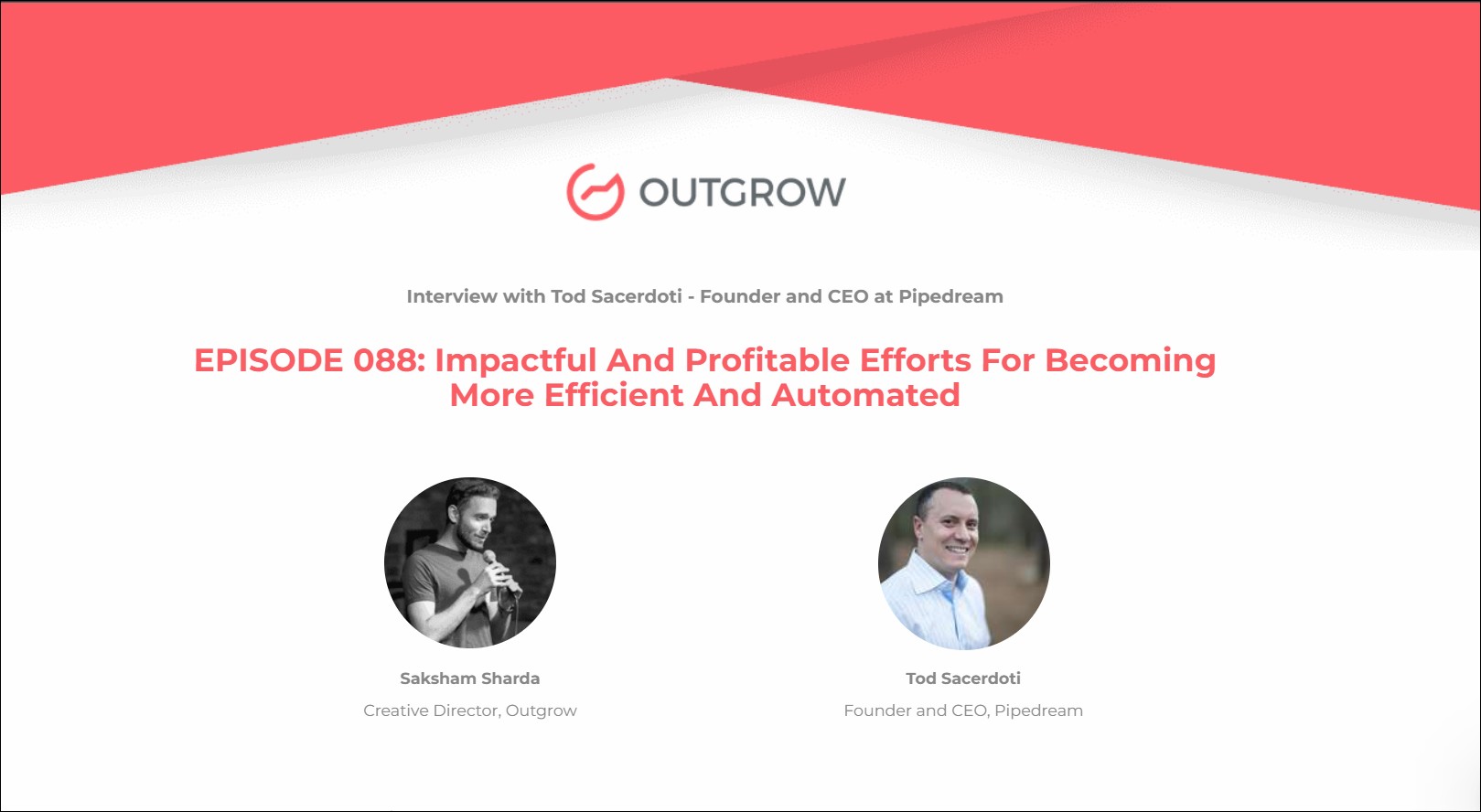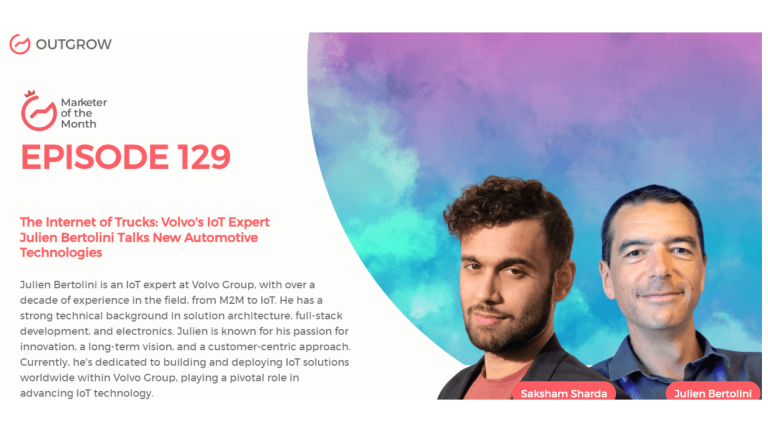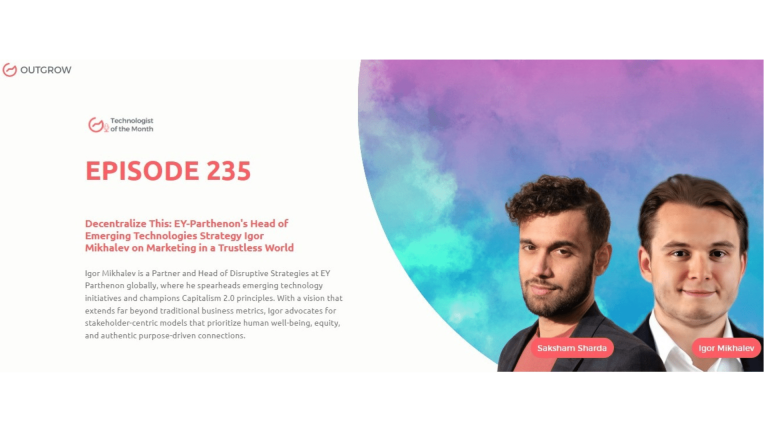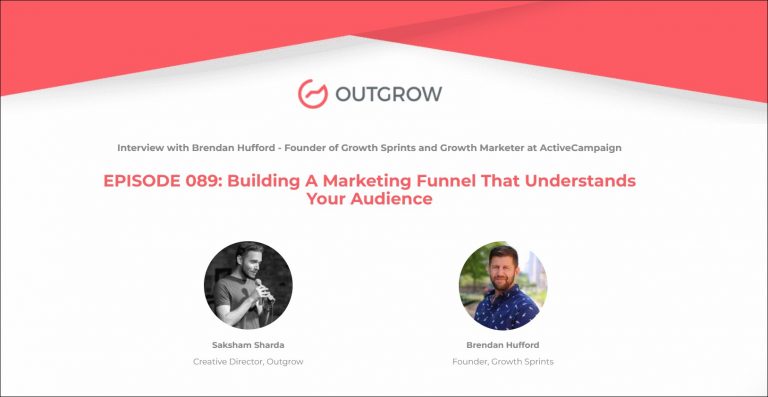EPISODE 088: Marketer of the Month Podcast with Tod Sacerdoti
Table of Contents
Hey there! Welcome to the Marketer Of The Month blog!
We recently interviewed Tod Sacerdoti for our monthly podcast – ‘Marketer of the Month’! We had some amazing insightful conversations with Tod and here’s what we discussed about –
1. Establishing genuine, meaningful connections and long-term relationships
2. How to hire the best talent for rapid growth in a startup
3. Outperforming application integrations in 2022 and the future of APIs
4. Disciplines to create and deliver value in different fields
5. Technology investment areas to watch in 2022
6. Finding the next Uber or Facebook – VC tactics to identify the right companies
About our host:
Dr. Saksham Sharda is the Chief Information Officer at Outgrow.co. He specializes in data collection, analysis, filtering, and transfer by the means of widgets and applets. Interactive, cultural, and trending widgets designed by him have been featured on TrendHunter, Alibaba, ProductHunt, New York Marketing Association, FactoryBerlin, Digimarcon Silicon Valley, and at The European Affiliate Summit.
About our guest:
2x CEO with a $640 million exit and early investments in unicorns AppLovin and Chime, Tod Sacerdoti is Founder and CEO at Pipedream, a platform that lets developers connect APIs remarkably fast. In this episode of Marketer of the Month, we sit down with Tod to learn more about the lessons he’s learned from his incredibly successful career, automations and efficiencies in today’s world, and building a product of the future.
Impactful and Profitable Efforts for Becoming More Efficient and Automated
The Intro!
Saksham Sharda: Hi everyone. Welcome to another episode of Outgrow’s Marketer of the Month. I’m your host, Dr. Saksham Sharda, I’m the Creative Director at Outgrow. co. And for this month we are going to interview Tod Sacerdoti who is the CEO of Pipedream. Thanks for joining us, Tod.
Tod Sacerdoti: Thanks for having me.
Don’t have time to read? No problem, just watch the Podcast!
Or you can just listen to it on Spotify!
The Rapid Fire Round!
Saksham Sharda: So Tod, we’re going to start with a rapid-fire round just to break the ice, you’d get three passes. In case you don’t want to answer the question, you can just say pass. But try to keep your answers to one word or one sentence only. Okay?
Tod Sacerdoti: Okay.
Saksham Sharda: All right. So the first one is at what age do you want to retire?
Tod Sacerdoti: Never.
Saksham Sharda: How long does it take you to get ready in the mornings?
Tod Sacerdoti: About 30 minutes
Saksham Sharda: The most embarrassing moment of your life?
Tod Sacerdoti: I’ll pass on that one.
Saksham Sharda: The favorite color?
Tod Sacerdoti: Blue.
Saksham Sharda: What time of day are you most inspired?
Tod Sacerdoti: 11 pm.
Saksham Sharda: How many hours of sleep can you survive on?
Tod Sacerdoti: Five
Saksham Sharda: Fill in the blank: An upcoming marketing trend is _______.
Tod Sacerdoti: Oh, I’ll pass on that one.
Saksham Sharda: The city in which the best kiss of your life happened?
Tod Sacerdoti: San Francisco for sure.
Saksham Sharda: Pick one – Mark Zuckerberg or Jack Dorsey?
Tod Sacerdoti: Jack Dorsey.
Saksham Sharda: The biggest mistake of your career?
Tod Sacerdoti: Not working at Facebook.
Saksham Sharda: How do you relax?
Tod Sacerdoti: Sports
Saksham Sharda: How many cups of coffee do you drink per day?
Tod Sacerdoti: Zero to One
Saksham Sharda: A habit of yours that you hate?
Tod Sacerdoti: Competitiveness
Saksham Sharda: The most valuable skill you’ve learned in life?
Tod Sacerdoti: Competitiveness.
Saksham Sharda: The last question is your favorite Netflix show?
Tod Sacerdoti: I’d say “Narcos”, at the moment.
Saksham Sharda: Okay. All right. Well, that was the end of the rapid-fire round.
The Big Questions!
Saksham Sharda: Now we’re going to go on to the long-form questions. And you can answer as long as you like. And the first one is, you’ve talked about how important networking is. So in your opinion, how can one identify ways to develop long-term effective relationships? And should relationships in your opinion be completely transactional?
Tod Sacerdoti: I mean, the answer to the last part is definitive no. I’ve talked to other podcasts a lot about building long-term relationships. And I think being non-transactional is probably the core element of sort of seeking those out and being successful with them. I’ll give you an example. Because it’s very top of mine. In the last few weeks or so I’ve been just getting bombarded with sales emails to myself as a CEO of Pipedream, typically from companies that we’re already working with. You could argue that we already have existing, maybe near-near-term or recent-term relationships. And I’m astounded how often the relationships are approached in essentially a purely transactional way. And I would say, the vast majority 90% + have a silver platter, a way to build a real relationship, find win-win, find ways to help our business to grow our relationships with them. And yet the easy path, the simple thing to do is just make it entirely transactional, ask for money and focus elsewhere. If it’s not an easy win, and that never drives, long-term value in effective relationships.
Saksham Sharda: So what’s a good example of relationship building that you would give?
Tod Sacerdoti: In the sales call, most of my discussions are about kind of being a co-founder, but I’ll take the sales example as a test case here. But the absolute first question that every salesperson should ask when they contact me is, how could we help you grow your business? I mean, that’s what I care about as the CEO of the company. First and foremost I’m trying to build a startup into a meaningful, rapidly growing company. And many of these companies that we contract with, I’m talking about companies like AWS, Snowflake, Redis, and Twilio, these companies can help our businesses in very material ways, probably in ways that the salesperson has direct access to. And it’s literally like, the first five minutes of a 30-minute conversation could just be about, let me learn more about your business and how I can help you. And instead, they’re approached with generally like, how much are you spending today? What would it take to get you to spend more tomorrow? And it’s just completely backward. I mean, my response to that, and in most cases is I’d rather not take the call, just do it over email and it’s just a negotiation, right? There’s no relationship-building at all.
Saksham Sharda: And so what kind of employment or recruitment techniques should one employ to get the right people? So we had startup founders say that compared to recruiting fundraising was easy. What are the ways startups can hire the best talent for this kind of relationship-building and growth?
Tod Sacerdoti: I mean, anyone who says fundraising was easy, was probably being interviewed in 2021, not 2022. You know, fundraising isn’t as easy as it has been recently. But that all said, I think it is fair to say that raising money is far easier than it’s been historical. I mean, the things that we think about internally in Pipedream in terms of attracting great talent, first and foremost, is to be a remote company, right? My last company was based in Silicon Valley, and we hired locally, I now run a fully remote company, we hire across the entire country, and just having a much larger pool of candidates is a great place to start. Secondly, I talked about running downhill, like, building a product that people want to work for. The last company I ran was an ad tech company, and convincing, like top tier developers to spend, all of their time and energy on making ads more effective was a hard sell. Right. And, you know, I now work for a company that builds products for other developers, like many developers love the idea of working for a company that builds products for them and their peers. And by the way, it doesn’t have to be developer tools specifically. I’m just saying, like what product you’re building does materially matter in your ability to recruit great people. And then I’d say the last thing, which I think is most in people’s founders’ control, which is to make working at your company, the best part of a job at your company. At my last company, we were at 400 employees, and we were hiring, 10s of people a month, and I would do this cocktail, hours with people who had recently joined the company. And I would ask them, like, why did you join? And I was always waiting for them to say, “Oh the CEOs, visionary, or the company is so differentiated. And it’s going to do well.” And that was never the answer the answer was interviewing at this company made me realize I would love working there. Right? That’s completely in the control of the founder and CEO and the team, which is like, when someone’s making a judgment, what it’s like to work there, the best data they have is what it was like to interview there. Right. And if your interview process sucks, it probably sucks to work there. I mean, that’s just the facts. So those are at least the things that are top of mind, for me, at least in terms of attracting great talent today.
Saksham Sharda: And so for those of the listeners who don’t know what Pipedream does, could you explain in a sentence or two what Pipedream does?
Tod Sacerdoti: Yeah, Pipedream is an integration platform for developers that lets developers quickly build workflows connecting thousands of SaaS apps, primarily on the web. A lot of people call it Zapier for developers, is a shorthand if you want a Hollywood analogy.
Saksham Sharda: So this is like a Zapier for you’re saying, developers?
Tod Sacerdoti: That is often how our product is described by our customers. Yes.
Saksham Sharda: And when did this term come along in your journey and Pipedream? At what point did this analogy start being applied?
Tod Sacerdoti: I think Zapier is probably the most well-known integration platform by no means is it the only and it’s not a product targeted at technical users. But whenever there’s a company that’s a wild success which Zapier is, people often use it as the cornerstone of their analogy. And many developers, I think, for a long time, have loved the abstractions that Zapier provided, they just didn’t like that they would no longer have code-level control of their workflows. So we often use the phrase code level control when you need it and no code when you don’t. Whereas Zapier and its 1000 Zapier clones are for knowledge workers. And it’s a no-code tool, full stop.
Saksham Sharda: So how a business wins or loses is increasingly dependent nowadays on how well they connect to external party apps, devices, or services. So what is your opinion is the future of API? And to what extent are they going to affect the way business is done in these times?
Tod Sacerdoti: Yeah, I mean what’s interesting about that question is that I think actually, it’s easier than ever for companies to sort of connect with other companies via API. And that’s because there are so many integration-type platforms available. So I sort of think the market will bifurcate where companies will be responsible for what I call the blockbuster integrations. The integrations that every user expects to be, like first class in the product, and is complete, like integrated in a way that as if it was a feature built by the product that you’re using, those will almost always be built by the company directly. The second category which is the majority of the other integrations, historically, would have to be built by a product. And now I think many of those can be solved by third-party platforms. And then I think the piece that has historically been unsolved and is now going to be solved almost exclusively by third parties is like the longtail now we’re talking about these integration platforms now solving 1000s of integrations, not hundreds. And so it’s very unlikely that you won’t be able to find a way to connect whatever app it is you’re using with whatever other app you use internally. So I think all that’s getting easier. So in many ways for the core company that you’re asking the question about here? I think that you just focus on the blockbuster integrations, and you make sure that they’re world-class.
Saksham Sharda: And how does one go about picking the blockbuster integrations?
Tod Sacerdoti: Usually, they’re clear, I mean the whole reason there are quote, unquote, blockbusters are because every user wants them like I always say, like if your users want to get notified about changes in the app, or errors, or something like that, in Slack, that’s like an obvious blockbuster integration, like a large percentage of company customers need to get notified, and a large percentage of them use Slack. So they would expect one click, to get notified in Slack as a feature. But like, does that mean they expect to get notified in discord or matter most? Or by SMS or by some other longer tail thing? Probably not. Those aren’t, I think, reasonable expectations. So when I say blockbuster, it should almost be so obvious. You don’t have to do any work. The harder question is when you get out of the blockbuster ones, and you’re like, well some of our customers like it. And we think we could drive revenue. But we don’t think it applies to that many of our customers, that’s not a blockbuster integration, and that’s likely where third parties will come in.
Saksham Sharda: And so what are some of the upcoming integrations that you’ve seen in your platform?
Tod Sacerdoti: That’s a great question. I’d say we’ve been surprised by I mean, none of these are going to be a total shock, I guess once you think about them. But we’ve been surprised recently by Notion. The notion, I would say is far ahead of where we would have anticipated it. Air table and Discord were kind of like the last generation of things that surprised us. More than anything, the two categories, I would say that our most commonly outperforming versus expectation is, one is sending message sending like data to a “database”. And I use air quotes because that could mean snowflake. But it could also mean Google Sheets, Notion, or Air Table. So sort of like lightweight databases, it’s probably one. And then the second is sending data in the messaging, and notification messaging apps, many of which I already mentioned. So those two categories are probably the most outperforming on a relative basis.
Saksham Sharda: And do you inform these particular companies that they’re doing better on your platform or do they get to know automatically? Or does their behavior change once they get to know that they’re doing better on these?
Tod Sacerdoti: Yeah, I mean, it’s better I guess, it’s all relative. Some of these products have like 10 million users, right? So if we have 1000s or 10,000s of users using it, it’s significant to us, it’s less significant to them. But I would say that we notice a very clear progression, which is, as apps get used more on our platform, those apps spend more time making sure that our integration into them is great. Not all of them do the work to do those integrations, some of them do. But many of them will sort of partner with and or kind of advise or support the integration in any way they can. So it’s sort of like the more relevant we are to their business, the more attention they spend on it, but we don’t architect the business assuming that their participation is required, like we’re going to support Notion no matter what, if it’s a mediocre integration, it’s better than nothing. But we would like it to be as world-class as possible.
Saksham Sharda: So you worked in several businesses across specific disciplines that may be common to each of the businesses that you’ve worked with. So what are some of the specific disciplines common to each of these businesses that you have worked with that create and deliver value in their particular fields?
Tod Sacerdoti: Yeah, maybe it’s worth digging a little bit into the question because, in my mind, there are lots of loose similarities across different categories. But if I’ve learned anything from being an investor it’s almost the things that are anomalous in these companies that make companies most great. So if I’m always looking for the same playbook that I’ve seen work at other companies, I find that will almost inevitably lead me to miss, the best opportunities. So I almost spend my time as an investor on the exact opposite, which is like, what is it about this business that is so different from anything I’ve ever seen before, that makes it worthy of like spending the additional time and understanding because those are usually like the best outcomes and I’ll just give some simple examples, like, maybe they have a way of acquiring customers that’s free and extremely scalable, but I’ve never seen any company succeed at doing so. Or maybe the majority of their product is built by their community in a way that they just have engagement that’s so far beyond anything I’d seen in any other company. Or maybe they’re able to deliver their service in a way, that’s so much more cost-effective than any other company I had seen, those are the types of things that lead I think to the best investments, as opposed to, I like investing in companies that, acquire their customers from search, and I’ve done five deals, and I’m looking for five more, you can do well there, but I think it’s very hard to find, like the true outliers in that model. Because likely, 50 other people are doing the same sort of filtering of companies.
Saksham Sharda: So based on your industry and investing experience, where do you think the future of SaaS is headed as a whole?
Tod Sacerdoti: That’s a pretty broad question. I would start by saying that I couldn’t be more bullish on B2B SaaS software than I am currently. So I know, we had a huge run-up over the last like five years. And the last, let’s call it six to nine months has been pretty brutal, and valuations have come down dramatically. But I always share this sort of anecdote that, a few years ago, I’d probably only seen 100, or maybe 200 businesses in detail. And now I’m probably in the, you know, closer to 1000 businesses in detail. And what I’ve learned is, at any time in any market, in any valuation environment, there are truly amazing B2B SaaS companies being built that have zero customer acquisition costs, 90 plus percent margins, and are growing at 5x year over year. And these businesses, oftentimes are in like, relatively small niches when they start, but there’s just no way those businesses are not going to be significant over time. And so I guess, if I would just summarize, the future of SaaS, to me is just, there’s going to be more B2B SaaS companies in every category than there are today. And they’re going to be truly amazing businesses created in those niches. So I’m excited about what the future holds for SaaS.
Saksham Sharda: And could you give us an example of some of these B2B SaaS companies that are solving these niche problems?
Tod Sacerdoti: I would say at a high level, I hate when sorting of investors like talking about their book of companies they’ve invested. But I’ll just give you some example categories. So we invest a lot in data companies. And in the history of the internet, it’s never been bigger and more profitable for companies to sell data. And so it’s way cheaper today to build data companies than it’s ever been because of all the cloud providers. So within the data category, there are lots of niches, right? There’s data for academia, there’s data for marketing, there are machine learning models that use data, that’s probably the vendor, and there’s data being applied in every category. So that’s one we spend a lot of time on, I would say. Secondly, the most exciting category right now is applied AI, which is from a consumer standpoint, being talked about in all these, like image generation sites, but we’re seeing it applied in almost every business category in which it would make sense. And so it’s never been cheaper to build those companies. It’s never been cheaper to deliver those services. So it can be anything from like writing marketing copy to figuring out fraud within the FinTech companies, and insurance books. Let’s say we see it as an applied AI probably more than any other category. And then lastly, I would just say that like within vertical SaaS, these are the classic niche category, which could be software for architects or software for dentists or software for like any vertical. There seems to be a continued kind of like endless stream of opportunity to provide automation within a specific vertical and get 50 plus percent market share in those niches, and then eventually expand to adjacent categories than we’ve ever seen. So, at a high level, those are three just broad areas where we’re seeing great, great opportunities.
Saksham Sharda: And speaking of FinTech companies, fintech typically begins disrupting the market with ambitious goals, but quickly realizes it would be difficult and expensive to attack the market directly. So would you say that turning to partnerships with established players to benefit from the existing reputation, financial means, and customer bases is the best course of action in this situation?
Tod Sacerdoti: I don’t run a FinTech company. So I always sort of like defer to founders who do but I have invested and actually, some of the best investments in my life have been in FinTech companies. And I would just say that this advice doesn’t exactly match my experience with those investments. Like I think partnerships, in general, can help startups, FinTech or otherwise, but I think they’re rarely a panacea. Because finding product market fit and creating some sort of like market disruption. An advantage is a goal. And partnerships can be easily replicated. So I’ve found at least particularly early in a startup journey, partnerships, typically, like remove the focus on product innovation, rather than encourage it because they sort of like distract the team to rely on the brand and the halo from the partner. And oftentimes, those partners don’t want to King make a single startup, right? So they’ll likely work with your direct competitors, as well. And so it’s like, you kind of want to, I think make market disruption in ways where you can like close the door behind you. Partnerships generally aren’t that. Partnerships are generally like doors, “Oh, you’ve opened the door, you’ve proven the model, and you’re letting other people come in. So that can be helpful.” But I wouldn’t say I would recommend it first or look for it when I’m trying to understand why somebody’s doing particularly well.
Saksham Sharda: And so when it comes to investing again, what are some tactics that VCs use when it comes to finding the right companies? I know, you’ve told us one of your tactics, but in general, what are people using?
Tod Sacerdoti: Well, I think the term innovative may not be the right word, but sort of like the best modern, innovative, like, of this moment VC firms, look more like companies than they do look like traditional partnerships. They have data science teams, that are using data to identify companies to reach out to that they think are doing particularly well. And they have like inside sales teams, they would never describe it as that, but they’re basically inside sales teams where partners or junior partners are sort of like programmatically using marketing tools to outreach to founders. So you have one team kind of identifying companies and another team reaching out and trying to build those relationships to like get access, and then who invest I think is a little bit dependent on the firm. But what’s most interesting to me about these sort of modern, best firms is that they’re kind of like partner independent meaning like, it’s the same way at like a software company, we used to have good salespeople, and not as good salespeople, but you can swap out, you can hire a new salesperson, they can be successful, like these new firms, they can hire new partners and swap them out. And they’re not dependent on like the individual relationships of some Hero partners like the traditional firms were. And so to me, that’s the most interesting, which is like, they’re starting to use the best practices from software, to build investment businesses. And in many ways, they’re fundamentally changing the dynamics of the investment industry as a result.
Saksham Sharda: And so where is the investment industry headed in that case?
Tod Sacerdoti: Well, you could argue that if we follow that path that you’ll have kind of it, you’ll never have a real change in the Guard, the absolute top like the top tier, five to 10 firms, I don’t think those change. But I do think you’ll have a kind of changing of the guard within that kind of middle range where probably the majority of the money is. So I think that’s exciting for Silicon Valley and tech in general. I will say, as a founder who’s bombarded with inside sales emails, I’m not convinced that this process will scale. So I think that there is a little bit of reckoning coming down, where some of these new innovative firms like every software sales team ever, by the way, are going to realize over time that technique is not going to continue to work as everyone replicates it. So, I think that means that there’s going to be, as there always is, like the next wave of differentiation on the DC side if I knew what that was, I would do it. But it’s hard to know exactly what it is at this time.
Saksham Sharda: Applied AI then gonna make an inroad?
Tod Sacerdoti: I’ve personally looked at a bunch of these companies that are like doing the identification, like, “oh, here are the 10 best companies”. And it’s like I’d say the majority of the time, I’m underwhelmed, but every once in a while you look at a list, and you’re like de-identified a small number of companies, of which I probably would never have heard of any of them. And let’s say a list of 10 or 20, that are like their number one recommendation at this moment in time. And some of them are amazing, right? So it’s like you’re starting to see, it’s not applied AI as much as probably like, machine learning. But some pockets pique my interest, I guess.
Saksham Sharda: All right. So the last question for you is a personal question, which is what would you be doing in your life if not all this?
Tod Sacerdoti: Good question. My favorite answer to this question is that anyone ever said, when I asked them as they said, I’d be a cult leader but that doesn’t resonate with me. I’m at my core, I’m a builder, right? So if I wasn’t building companies, I would be building something else. I’m not the inventor, the recluse inventor, like in a basement with no windows tinkering type. But I’d be wanting to build something. So whether that’s something physical or an organization or a nonprofit, I’d be building something that had meaning to me and hopefully mean other people.
Saksham Sharda: Okay. All right. Well, that was the last question.
Let’s Conclude!
Saksham Sharda: Thanks, everyone for joining us for this month’s episode of Outgrow’s Marketer of the Month. That was Tod Sacerdoti, who is the CEO at Pipedream. Thanks for joining us, Tod.
Tod Sacerdoti: Thanks for having me.
Saksham Sharda: Check out the website for more details and we’ll see you once again next month with another marketer of the month.









